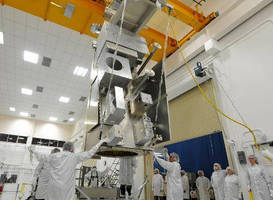Ball Aerospace Completes Primary Structure for JPSS-1
Share:

First Joint Polar Satellite System spacecraft on schedule for 2017 launch
BOULDER, Colo. - Ball Aerospace & Technologies Corp. has achieved a pivotal milestone for assuring continuity of the nation's future weather and storm forecasting by completing the primary bus structure of the first satellite in the Joint Polar Satellite System (JPSS-1). JPSS-1 is the follow-on in a series of next generation satellites and is scheduled for launch in early 2017.
Procured by the National Oceanic and Atmospheric Administration (NOAA), through the National Aeronautics and Space Administration (NASA), JPSS-1 will continue the observations now provided by the Suomi National Polar-orbiting Partnership (Suomi NPP) satellite, also built by Ball and launched in 2011. The continuity these satellites provide on orbit is critical for ensuring the nation's ability to accurately predict severe weather.
"We remain ahead of schedule in meeting our milestones," said Cary Ludtke, vice president and general manager for Ball's Operational Space business unit. "JPSS-1 will operationalize the advanced technologies currently being demonstrated on Suomi NPP, and with the satellite's core structure complete, we can now push on to assembly, integration and test as we prepare for instrument integration in November 2014."
JPSS will fly a suite of advanced technology remote-sensing instruments that includes:
-Â Visible/Infrared Imaging Radiometer Suite (VIIRS)
-Â Cross-track Infrared Sounder (CrIS)
-Â Advanced Technology Microwave Sounder (ATMS)
-Â Ozone Mapping and Profiler Suite (OMPS)
-Â Clouds and the Earth's Radiant Energy System (CERES)
Ball is under contract to NASA's Goddard Space Flight Center to design and build the JPSS-1 satellite bus, the Ozone Mapping and Profiler Suite (OMPS) instrument, integrate all instruments, and perform satellite-level testing and launch support.
JPSS-1 will provide essential data for civil and military weather-forecasting, storm tracking, and climate-monitoring. The data from JPSS-1 will be used by the National Weather Service in models for forecasts three to seven days ahead of a severe weather event. This weather forecasting will allow scientists and forecasters to monitor and predict weather patterns with greater speed and accuracy, while also giving emergency managers and the public time to prepare.
Ball Aerospace & Technologies Corp. supports critical missions for national agencies such as the Department of Defense, NASA, NOAA and other U.S. government and commercial entities. The company develops and manufactures spacecraft, advanced instruments and sensors, components, data exploitation systems and RF solutions for strategic, tactical and scientific applications. For more information, visit www.ballaerospace.com.
Ball Corporation (NYSE: BLL) supplies innovative, sustainable packaging solutions for beverage, food and household products customers, as well as aerospace and other technologies and services primarily for the U.S. government. Ball Corporation and its subsidiaries employ 15,000 people worldwide and reported 2012 sales of more than $8.7 billion. For more information, visit www.ball.com, or connect with us on Facebook or Twitter.
Source
Ball Aerospace & Technologies Corp.
Contact:
Roz Brown, 303-533-6059, rbrown@ball.com
Web Site: http://www.ballaerospace.com




